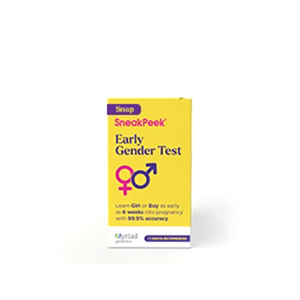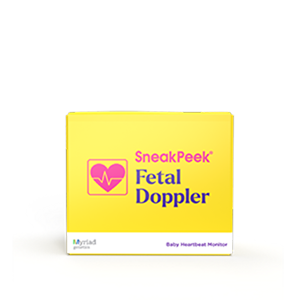Published on July 21st, 2021 and Updated on January 15th, 2024
Check out SneakPeek Gender Test to find out your baby’s gender as early as 6 weeks at over 99% accuracy1!
Fuzzy mini afghans hand-knit by your artsy best friend, quilts stitched by doting grandparents, soft, fleece blankets dotted with duckies from your coworkers—why is it that some of the cutest baby gifts are blankets? Maybe because there’s nothing more adorable than a baby bedbug all snug under a comfy blanket, dreaming away.
As much as you’re itching to tuck your little one into bed with one of Grandma’s beautiful quilts, you might have a little while to wait. So, when can babies sleep with a blanket?
The American Academy of Pediatrics advises parents to hold off on blankets (or any kind of bedding) until your child is at least 12 months old.
Why It’s Important to Wait To Introduce a Blanket
Before your baby arrived, you probably remember baby-proofing every potential danger in your home. Some practices are no-brainers, like covering outlets to protect curious little fingers or bolting bookcases to the wall as coverage for climbing monkeys. This is the stage in your child’s life when she’s most vulnerable, and sleeping is no exception.
According to data around infant sleep deaths and SIDS (sudden infant death syndrome), keeping a baby’s crib blanket-free is one of the best ways to create a safe sleep environment and increase sleep safety for your baby.
Until she’s about one, blankets pose a risk to your little one, including:
- Strangulation – A baby’s nightly wiggles paired with a blanket may put her at risk for strangulation.
- Suffocation – Your baby’s motor function (and to be frank, survival skills) are still developing. If a piece of fabric covers her nose and mouth, she may not be able to move the item blocking her breathing pathways.
- Choking – As most parents know, babies are prone to Grab-and-Put-in-Mouth Syndrome (not a real medical condition, but definitely a reality for Mom and Dad!). However, when little hands grab things too big for them, it can lead to a choking hazard. The soft edge of a blanket can pose this risk.
What about toys, stuffed animals, or other snuggly comfort items?
Even if your bed bug would rather snuggle with his favorite froggy toy, it’s best to keep your baby’s crib space down to the essentials: mattress, crib sheet (firmly tucked in), and baby.
Just like blankets, toys and stuffed animals shouldn’t be left in the crib with a child. They pose similar threats as blankets and could put your child in danger.
So just to be safe:
- Toys should stay out of the crib when a baby sleeps
- Stuffed animals can be played with when the baby is awake and supervised
- Hold off on comfort items (also called loveys) until your child has reached around 12 months of age
Safe Sleep Tips for Your Little One
You might be thinking “Literally everything is out to get my baby, what do I do?” Don’t worry, here’s a way to make safe sleeping as easy as ABC:
- A – Alone: When your baby is ready for bedtime, he’ll have to wave “bye bye” to his vast friend group of stuffed animals and toys. Some pediatricians advise refraining from family sleep in Mom and Dad’s bed to make sure no one rolls off, or onto the baby. If you do decide to try co-sleeping, be sure to remove all of the blankets, sheets, and pillows from the baby’s sleep area. This is also one of the best solutions if your baby is fighting sleep.
- B – Back: Until your child has mastered sitting upright and rolling from belly to back, place him on his back to sleep. Once he has enough control to roll on his own, starting with back will be less important because he’ll be able to adjust his position to breathe and sleep safely.
- C – Crib: Child’s cribs, bassinets, or playpens meant for infant sleep are the perfect places for your little one to catch some zzz’s. Bouncers or swings, however, are made for play and not for nap time. Bouncers and swings aren’t built to support your child’s spine, neck, and hips when he isn’t alert and playing. When a baby falls asleep, his limbs go limp, which is fine if he’s safe and snug in his crib.
But, if a baby falls asleep in a swinger, his body will go limp without the support he needs to keep his body in a healthy alignment. This can increase your child’s risk of suffocation. If your little one’s eyelids start to droop during playtime, transfer him to a sleep spot—like a bassinet, crib, or sleep-safe play pen—that will keep him secure.
The ABCs are a great guide for safe sleep practices. Additionally, pediatricians provide a few more letters of the alphabet to keep your little one snoozing safely (and give you some worry-free sleep as well!).
- D – Dress for sleep success: Without a baby blanket to snuggle up in, your baby has to rely on Mom and Dad’s proxy fashion sense to dress her for a perfect night out in Dream Town. A good rule of thumb is to dress your child in one more layer than you’d wear yourself.
Worried about over or under-heating your little one? Check the back of her neck—if it’s cool to the touch, bundle her up in another layer. If it’s a little sweaty, peel back a layer and let her enjoy a temperate night’s sleep. You can also keep your baby’s sleeping area cool (between 68° and 72°F) to prevent overheating.
- E – Eliminate potential hazards near the crib: Remember GPIMS? Grab-and-Put-in-Mouth Syndrome? It’s best to remove any items from within your child’s reach when she’s sleeping. Clear crib-side tables and check your mobiles for small parts that could fall into the crib.
- F – Families that sleep near each other, sleep safer: Experts recommend that parents keep their child in their bedroom for the six months of life (or even up to a whole year). Keeping your sweet little roomie close will guarantee a quick response if something does happen—for instance, if the family pet decides to co-sleep with the new addition. It is also one of the surest ways to soothe a baby crying in sleep. When you’re not with your baby, try using a baby monitor so you can keep an ear or an eye on her nap.
- G – Get baby proofing: As your child gets older, she may want to put her climbing skills to the test, treating her crib like a personal escape room. Before your little one makes a break for it, double-check that the room is baby proofed.
If you haven’t baby proofed since you were pregnant, now is a perfect time to check that the safety measures you put in place can withstand your little one’s new powers of crawling, reaching, and grabbing.
How to Introduce Your Child to a Blanket
Blankets are more than just a warm piece of bedding to children. Blankets are a source of comfort and companionship – just ask Linus from Peanuts. They help your child transition from sleeping in his crib to his toddler bed (new bed, same blankie!). Blankets can also ease your child into new situations such as daycare or long weekends at Grandma’s house. A blanket becomes one of your baby’s earliest sources of security and can be a wonderful tool for him to get a good night’s sleep.
Step 1: Look for the Signs Your Child is Ready for a Blanket
If your son has just blown out his first birthday candle (maybe with a little help from his parents), you might be wondering if part of his birthday gift should be a night with his first baby blanket. Every baby grows at his own pace. Keep an eye out for the following indicators that your child might be ready for a blanket:
- Age – After age one, your child has developed enough to mitigate some of the hazards of sleeping with a blanket. At this age, babies have grown enough that airways have broadened to minimize choking risks. They’ve also had lots of practice moving around and building up their strength so they can move a blanket according to their comfort levels.
- Motor skills – Will your baby be ready for a blanket at the stroke of midnight? Probably not. Everyone develops differently. It’s more important that your child has the skills to handle a blanket, regardless of age. When a baby can move freely or move items around comfortably, it might be a sign that it’s blanket time. This can happen anywhere between 12 and 24 months.
- Head control – “Support the head, support the head!” is a mantra you might repeat to first-time baby-holders meeting your baby for the first time (or to yourself when you meet your baby for the first time). When your baby can support his head with the strength of his adorable neck, it means he’s on the way to being able to lift his head away from hazards (such as a blanket).
When all the above milestones have been met, your child is primed and ready for a bedtime blanket.
Step 2: Start with a Lovey
Blankets might seem odd to a baby. Your baby can’t eat it, and it’s not entertaining (yet). It’s just a strange soft square. After sleeping in just a swaddle, sleep sack, or pajamas, your child might react to a blanket with a surprised look that asks, “What am I supposed to do with this?”
Instead of jumping straight into blankets, parents will sometimes opt to introduce their child to loveys first. Loveys are thin cloth blankets attached to stuffed animals that let your child recognize a familiar friend and get used to the added feature of the blanket.
Try these tips to prime your child’s lovey for snooze time:
- Sleep with the lovey for a few nights to infuse it with your comforting Mom-scent.
- Only show it to your child at bedtime so he gets that this new addition to his stuffed animal family is for sleep not play.
- Get two (or three, or a dozen) of the same kind of lovey. If your little one can’t sleep without his favorite snuggle buddy and it gets left in the car, at Grandma’s, or in the laundry basket, you’ll be glad to have a backup.
- Choose a washable lovey to keep your baby’s sleep environment safe and hygienic.
If your little one doesn’t fall asleep easily with a lovey, that’s okay. The lovey might be too much of a distraction for him to relax all the way to sleep, or maybe your baby just isn’t into it. You can instead go straight to step 3: trying a blanket.
Step 3: Move Up to a Blanket
When your child has practiced cuddling with a lovey or is ready to give blankets a try, take the same approach as you would with the lovey—sleep with it for a few nights, only use it during sleep or nap times, and choose something washable.
Additionally, you may want to:
- Avoid blankets (or loveys) that have filling such as fluff or beans to reduce the risk of choking
- Start with a light fabric that your child can easily maneuver in without difficulty
While the use of blankets in a baby’s crib comes with its undeniable charm and warmth, it is essential for parents to understand the potential risks they pose. As advised by experts, waiting until your child is at least 12 months old and gradually introducing comfort items like loveys or lightweight blankets can ensure safe and comfortable sleep for your little one.
If you have more questions around your baby’s sleep such as, “when do babies learn to sleep on their own” or “how to get your baby to sleep without being held”, read our linked articles!
Sources:
- AAP News & Journals. Updated safe sleep guidance warns against using soft bedding, sofa sleeping. https://www.aappublications.org/news/2016/10/24/SIDS102416
- Pediatrics. Sleep-Related Infant Suffocation Deaths Attributable to Soft Bedding, Overlay, and Wedging. https://pediatrics.aappublications.org/content/143/5/e20183408
- Pediatric Sleep Council. Is it safe for my baby to sleep in a swinger? https://www.babysleep.com/sleep-advice/is-it-safe-for-my-baby-to-sleep-in-a-swing/#:~:text=Newborns%20lack%20the%20muscle%20strength,hip%20support%20a%20baby%20needs.
- Pathways. ABCs of Safe Sleep. https://pathways.org/abcs-of-safe-sleep/
- Healthline. What is the Best Room Temperature for Baby? https://www.healthline.com/health/baby/room-temperature-for-baby
- Safe to Sleep. FAQ About SIDS and Infant Sleep. https://safetosleep.nichd.nih.gov/safesleepbasics/faq

Shop Our Products
SneakPeek aims to provide the most accurate and up-to-date information to help our readers make informed decisions regarding their health before, during, and after pregnancy. This article was written based upon trusted scientific research studies and/or articles. Credible information sources for this article are cited and hyperlinked.





